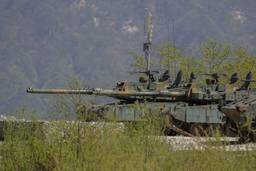The Accidental War
The Bush administration might not deliberately launch a war with Iran, heightened U.S.-Iran tensions could push some minor incident into a major conflict.
Brian Beutler, The Media Consortium
It’s become fashionable in conservative Washington circles – among commentators with extraordinary access to the Bush administration – to suggest that people concerned about the threat of war with Iran are howling at phantoms. As the New York Times’ David Brooks wrote in a Nov. 6 column, “The Bush administration is not about to bomb Iran (trust me). It’s using diplomacy to build a coalition to balance it, and reverse an ugly tide.”
Washington Post columnist George Will struck a slightly less friendly tone with those who would actually support strikes, but drew the same conclusion, writing on Nov. 11 that “some Washington voices, many of them familiar, are reprising a familiar theme • Iran’s nuclear program is near a fruition that justifies preventive military action. Whether or not these voices should be heeded … they will not be.”
It’s certainly clear that the White House has far less latitude to launch a unilateral, pre-emptive strike than it did in 2003. To put it mildly, few here or abroad are still willing to give President Bush the benefit of the doubt. But even if Brooks and Will are correct about the administration’s strategy, they’re ignoring, purposefully or otherwise, a much larger risk than a planed U.S. attack. There remains the very real threat of a war that erupts even when neither side wants it.
The relevant term of art here is “proximity of forces” – an inflamed constellation of hostile actors that includes the regionally loathed United States military, the Iranian Revolutionary Guard Corps and its elite Quds force, Shiite and Sunni militias in Iraq, al-Qaeda, the PKK in Kurdistan and the Israeli Defense Forces. With such a volatile maelstrom, there are countless opportunities for something to go amiss.
Steve Clemons, who directs the American Strategies program at the nonpartisan New America Foundation, recently wrote an article fleshing out the point. We should worry less about a preplanned attack, he argues, and more about “the kind of scenario David Wurmser [who sits on the vice president’s national security staff] floated, meaning an engineered provocation. An ‘accidental war’ would escalate quickly and ‘end run,’ as Wurmser put it, the president’s diplomatic, intelligence and military decision-making apparatus. It would most likely be triggered by one or both of the two people who would see their political fortunes rise through a new conflict – Cheney and Iranian President Mahmoud Ahmadinejad.”
Sabotage, for instance, is a real concern, Clemons argues. “Al-Qaeda-like interests could stage an attack made to look as if Israel was involved, or as if the Iranians did something to U.S. forces. … People talk about Gulf of Tonkin, but it doesn’t actually have to be that dramatic.”
Other possibilities? Renegade elements of the Quds force could kidnap U.S. soldiers. When Iranian forces kidnapped more than a dozen British sailors this spring, the two nations resolved the matter diplomatically. But by way of contrast, Hezbollah’s cross-border seizure of several IDF soldiers triggered a massive, deadly Israeli bombing campaign – one that turned Hezbollah leader Sheik Hassan Nasrallah into a folk hero in the Arab and Muslim worlds.
Paul Pillar, a CIA veteran who retired from a 28-year career in 2005 with the title of national intelligence officer for the Near East and South Asia, adds that such machinations aren’t even needed to spark a broad conflict. He recalled the accidental downing in 1988 of Iran Air commercial flight 655, which resulted in the deaths of all 290 passengers and crew. If something like that happened now, or if cross-border hostilities between the Revolutionary Guard and the Kurdish PKK resulted in the collateral deaths of U.S. soldiers, the fuse might burn too quickly to be stomped out. “With all the saber rattling and rhetoric we’ve had lately,” Pillar frets, “the risk is considerable.”
Iraq, of course, is the likeliest trigger. But even if the precipitating skirmish occurs unintentionally and outside Iran, the fight will no doubt be expanded to Iran’s nuclear facilities. James Dobbins, a RAND Corporation scholar who has been a diplomatic envoy to Afghanistan for Bush and to several military hot spots for the Clinton administration, wrote in an e-mail exchange last week that “if we are going to attack Iran, I expect we would not neglect to go after the nuclear facilities, so even if there was a different flashpoint, that conflict would likely escalate to that level.”
After all, with a Congress that’s been unable to restrain the Bush administration’s use of the military, and the administration’s own stubborn refusal to engage the Iranian regime directly, there are currently no political circuit breakers.
On Wednesday, Rep. John Tierney (D-Mass.) convened the third in a series of Iran hearings aimed at rebuilding those missing fail-safes. Tierney’s hearing gamed out the costs and consequences of an Iran conflict, accidental or otherwise, and retired U.S. Air Force Colonel Sam Gardiner offered a grim tally.
Gardiner said that if the objectives of military action were in fact to “punish Iran for its support of terrorism and attacks on U.S. troops in Iraq” and to “set back the Iranian nuclear program three to five years,” any U.S. strike would require an intricate and multi-pronged bombing campaign that, ultimately, wouldn’t be terribly effective anyway. We’d have little success inflicting real damage on the well-shielded Revolutionary Guard, Gardiner argued. And while the campaign could destroy three-to-five years worth of nuclear edifices and badly damage Iran’s conventional counter-strike capacity, the net effect could actually be to push Iran to an accelerate its nuclear program.
It would also set up a wide-range of more immediate threats, Gardiner argued. Depending upon how fiercely Tehran chose to retaliate, the U.S. could face any or all of the following: mob attacks against U.S. embassies and business interests across the world; sabotage of oil pipelines in Iraq; Iranian force escalation in Iraq; boat attacks against American naval vessels; and increasing instability and violence in and around Israel.
Worse still, Gardiner suggested, a commander in chief like George Bush would see few responses short of launching a still broader conflict aimed at Iranian regime change. Gardiner did not estimate the number – surely extraordinary – of lives that would be lost in the various phases of such a nightmare, but suffice it to say, he didn’t think it was worth the price.




